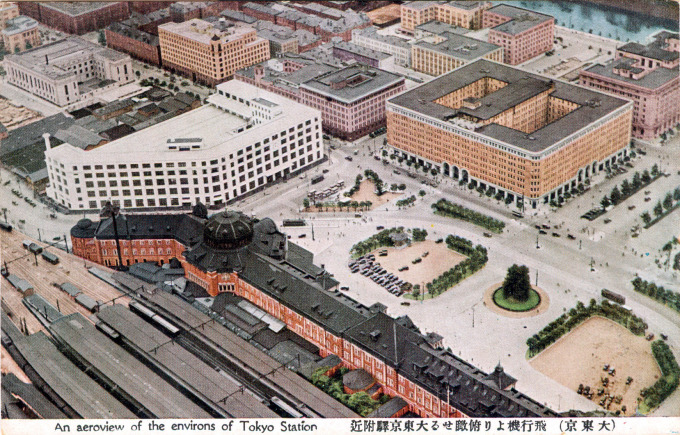
The completed Marunouchi Building, ca. 1925. Although it had a heavy “footprint,” the Maru Biru fit in well with the other “high-rise” office buildings in the district at the time. The Yusen Building, headquarters of the NYK shipping company, can be seen at the far right.
“The Marunouchi Building, being erected for the Mitsubishi Estate Department, will be the largest modern structure in the Orient. It will occupy a space 332 by 274 feet and will be ready for safe and comfortable occupancy within two years after commencement of construction.
“The building will have eleven elevators. It will be eight stories in height, with a basement of skeleton steel type construction and rests upon pile foundations. The treatment of the facades … will have an entirely new feature for buildings in Japan in that the arcades which traverse the ground floor will be lined with shops.
“The interiors of each of the buildings will be modern in every respect. The plumbing heating and wiring will be designed and installed in accordance with the best engineering practice.”
– The Trans-Pacific, Volume 5, edited by Benjamin Wilfried Fleisher, December 1921
![The grand sight of Tokyo Station, the entrance of capital [sic] in Japan, c. 1930.](https://www.oldtokyo.com/wp-content/uploads/2014/07/tokyo-station-marunouchi-bldg-child-680x437.jpg)
“The grand sight of Tokyo Station, the entrance of capital [sic] in Japan”. Evocative image of buildings in the distance from Tokyo Station’s north entrance, left to right: Marunouchi, NYK and Kaijo buildings, c. 1925.
“While nearby Nihonbashi is dominated by the greys and blues of men’s suits, Marunouchi has a long reputation of accommodating more working women than the rest of the city, and the symbol of this reputation is the old Maru Building.
“Standing in front of Tokyo Station, this building, built in 1923, survived the bombings of World War II and became famous for being home to many of Japan’s original ‘office ladies’, or OLs.”
– Goodbye Madame Butterfly: Sex, Marriage and the Modern Japanese Woman, Sumie Kawakami, 2007
Colloquially known as Maru-Biru, the Marunouchi Building was designed by Kotaro Sakurai and constructed 1923-1926 on land known as Mitsubishi ga hara [Mitsubishi’s field]. It was, for over 40 years, Japan’s largest (by volume) office building.
So voluminous was it, in fact, that popular cubic measures were often expressed as “so many Maru-Biru’s full,” e.g. “Japan’s beer consumption equals x number of Maru-Biru.” An example of a Japanese pun is the similarity in pronunciation between biru (building) and biiru (beer). In 2004, enough beer (biiru) was consumed in Japan (6.5-billion liters3/1.9-million meters3) to fill 3.3 Marunouchi Buildings (Marunouchi biru). Kanpai!
“Because of its rounded corners, the word ‘maru’ in Marunouchi is also play on the Japanese word for circle (maru, which is also used for ship names as a blessing for a safe round-trip voyage.
The Marunouchi Building dominated the business district from which it received its name. It survived both the 1923 Great Kanto earthquake and World War II firebombings with minimal damage — the former in part because its 371 offices sat atop more than 5400 pine pilings. Building restrictions that kept Tokyo buildings beneath a 100-foot height limit until 1968 resulted in a squat, heavy-set profile that occupied an entire city block, a first for Tokyo.
- A view of the Marunouchi Builiding (left) from Tokyo Station. To its right are the Yusen (left) and Kaijo (right) buildings, c. 1920.
- Marunouchi Building, c. 1930.
- Looking toward Tokyo Station, c. 1940. The Marunouchi Building is the tan-colored structure on the right.
- An aerial view of the Tokyo Station plaza, c. 1940. The Marunouchi Building is at right-of-center, across from the station terminal.
A similar-looking “sister” structure, the Shin [New] Marunouchi Building was completed in the post-war years. Its foundation was excavated in the 1930s but economic depression and wartime manpower needs meant that the hole remained a water-filled “pond” until construction of the building was completed in 1952.








Pingback: Central Post Office, Marunouchi, c. 1931. | Old Tokyo
Pingback: Aerial Views of Tokyo, c. 1940. | Old Tokyo
Pingback: U.S. Consulate, Yokohama, 1933. | Old Tokyo
Pingback: Crown Prince Hirohito’s Return to Japan from Europe, 1921. | Old Tokyo